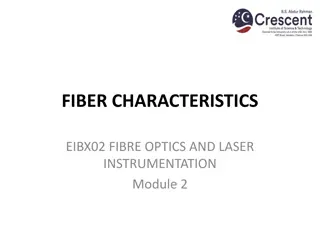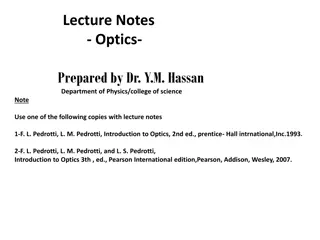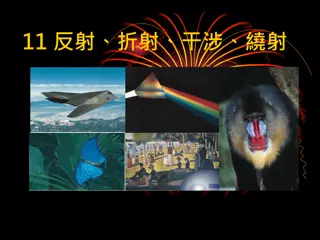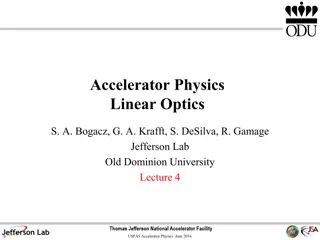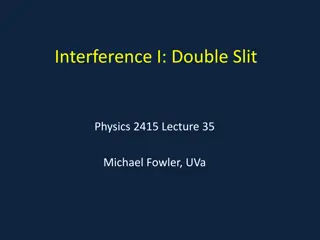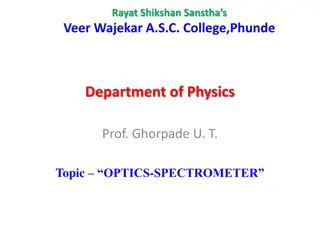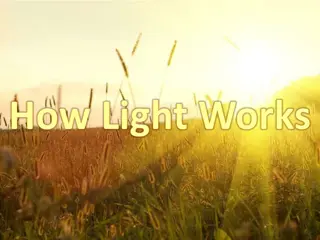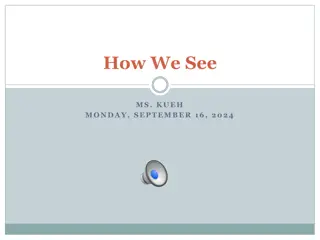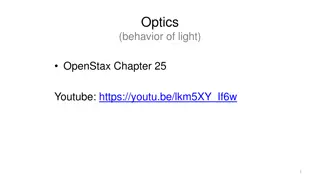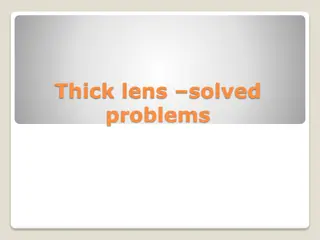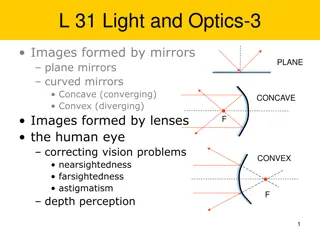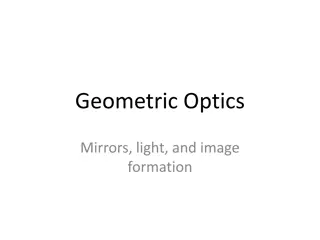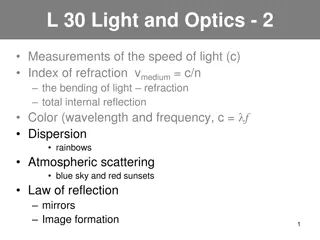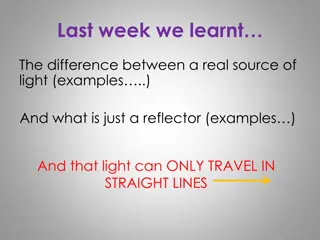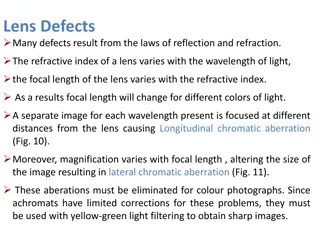Exploring Optics: Light Behavior and Properties
Optics studies the behavior of light, its interaction with matter, and the construction of instruments using or detecting light. From the dual nature of light to the laws of reflection and refraction, this branch of physics delves into topics like mirrors, lenses, and the dispersion of light. Practical applications in various fields make optics a vital area of study.
Download Presentation

Please find below an Image/Link to download the presentation.
The content on the website is provided AS IS for your information and personal use only. It may not be sold, licensed, or shared on other websites without obtaining consent from the author. Download presentation by click this link. If you encounter any issues during the download, it is possible that the publisher has removed the file from their server.
E N D
Presentation Transcript
Physics P 102 Optics Course contents: 1-Ray picture of light. 1-1-Introduction.( Optics - Source of light- Nature of light) 1-2-The dual nature of light and matter. 1-3-The law of Reflection and Refraction. 1-4-Snells law, Critical angle and total internal reflection. 1-5-Hygens's principle applied to Reflection and Refraction. 1-6-Fermat's Principal. 1-7-Dispersion of light. 2-Mirrors and lenses 2-1 - Introduction. 2-2- Images formed with plane mirrors. 2-3- Images formed with spherical concave and convex mirrors. 2-4-The General equation of the mirrors. 2-5-Lenses :General information about the lenses. 2-6-The images constructed by convex lens. 2-7-Applications on the optical devices. 2-8-Different disease affected the human eye .
Chapter 1 Ray Picture of light
1-1- Introduction. 1-1-a Optics. Optical fibers Optics is the branch of physics that studies the behavior and properties of light, including its interactions with matter and the construction of instruments that use or detect it. Optics usually describes the behavior of visible, ultraviolet, and infrared light. Because light is an electromagnetic wave, other forms of electromagnetic radiation such as X-rays, microwaves, and radio waves exhibit similar properties. Most optical phenomena can be accounted for using the classical electromagnetic description of light. Complete electromagnetic descriptions of light are, however, often difficult to apply in practice. Practical optics is usually done using simplified models: Geometrical optics, treats light as a collection of rays that travel in straight lines and bend when they pass through or reflect from surfaces. Physical optics is a more comprehensive model as diffraction and interference that cannot be accounted for in geometric optics. Optical science is relevant to and studied in many related disciplines including various engineering fields, photography, and medicine (particularly ophthalmology and optometry). Practical applications of optics are found in a variety of technologies and everyday objects, including mirrors, lenses, telescopes, microscopes, lasers, and fiber optics. of light, which includes wave effects such astronomy, Now it is very important to know , something about light and its different sources as an introduction to study ,its interaction with matter.
1-1-b-Source of light Natural sources Industrial sources Moon sun lightning Fire Falling star Candles Torches old lamp Non-self-lighting Self-lighting Shower Infrared image Optical fiber Coral reefs Tywan tears
1-1-c- Nature of light: Historical information: The Greeks believed that light consisted of tiny particles(corpuscles) that were emitted by light source and these particles stimulated the perception of vision upon a) b) Striking the observer's eye. Fig.(1-1 a, b) 1-Newton (at the 17 century) used this theory to explain the reflection and the refraction phenomena of light. He proposed that these particles have the following properties: a-They propagate in straight lines . b-At the surface which separating two different media, they are exposed to two short- range attractive and repulsive forces which support the reflection and the refraction phenomena of light ,as shown in Fig.(1-1-a,b) c-The particles emitted from the light source are stimulated the sense of sight upon entering the eye. The disadvantage of Newon,s theory: He could not explain refraction phenomena , because the speed of light in water higher than in air (this against the experimental observations). 2-The astronomerChristian Huygens showed that a wave theory of light could explain the reflection and the refraction phenomena of light ,see Fig.(1-2 a , b , c and d). Fig.(1 -2 a ) 3- Thomas's young (In 1801): He provided and applied the wave nature of light. Top Top Top Bottom Bottom
Huygens Principle: (wave theory of light ) Huygens Principle is a geometric construction: All points on a given wave front are taken as point sources to produce spherical Secondary waves, called wavelets which propagate outward through he medium with speed characteristic of waves in that medium after some time interval has passed, the new position of the wave front is the surface tangent to the wavelets , as shown in Fig.(1-2 b , c and d). Top D= V.t Distance = velocity x time The radius of each circles= r = c t b) c) d) Old wave front New Bottom wave front Old New wave front wave front Top Fig.(1-2 b , c and d)
4-Maxwell (1873): He asserted that light was a form of high-frequency electromagnetic waves ,as shown in Fig. (1-3). ? = 3x??? m/s Maxwell calculated the speed of these waves by his equation:? = ? ?? Where ? is the electric permittivity and ?? is the magnetic permeability of space. Fig. (1-3) The Electromagnetic spectrum: (as shown in Fig. (1-4)and application in Fig.(1-5) Light ,as Maxwell pointed out, is a member of the electromagnetic wave family . The spectrum of these waves covers the wide range of wavelengths( ?? ?? ~ ???? m ) , which corresponds to the frequency range( ??? ~ ???? Hz ) . These waves have electromagnetic nature and propagate in free space with speed of light C. V B G Y O R Fig. (1-5)Sensitivity spectrum of a standard eye Fig.(1-4)The Electromagnetic spectrum
Activity ( 1-2 ) Application of EM S General discussion.
5- Hertz (1887): Hertz proved experimentally that these Electromagnetic waves exhibit propagation characteristics like those of light; reflected ,refracted ,polarized, etc. **Although the wave model and the classical theory of electricity and magnetism were able to explain most known prosperities of light , they could not explain some experiments. The most striking of these is the photoelectric effect(Fig.1-6). Fig. (1-6) 6- Max Plank (1900): He discovers the quantization model of light as shown in Fig.(1-7). 7-Einstein (1905): The quantization model of light, which assumes that the energy of light wave is present in particles called Photons ,hence the energy is said is be quantized. He put his equation: E=hf where f is the frequency of the electromagnetic waves, and h is Plank's constant : h = ?.?? ??? ?? J/s. After all of these experiments from numerous scientists ,light must be regarded as having a dual Nature : (Light exhibit the characteristics of a wave in some situations and of a particle in other situations). So, the question : is light a wave or a particle? Fig.(1-7)
1-3- The law of Reflection and Refraction: Optics is the cornerstone of photonics systems and applications . It is divided into two main divisions: 1- Physical (wave) optics. This branch will help us to understand the phenomena of light wave interference , diffraction and polarization. 2- Geometrical (ray) optics. This branch will help us to understand the basics of light Reflection and Refraction and the use of simple optical elements such as mirrors, prisms, lenses and fibers . Fig. (1-9-a,b,c) explain to us , How light (rays) reflects or refracts at smooth, plane surface (in terms of straight lines ). a) b) b) c) Fig. (1-9-a, b, c)
Why it is more difficult to see while driving on a rainy night? If the road is wet , the smooth surface of the water specularly ) ) reflects most of your headlight beams away from your car ( and perhaps into the eyes of on coming drivers ). But , when the road is dry, its rough surface diffusely reflects part of your headlight beams back toward you, allowing you to see the highway more clearly. Secondly: 1- The law of reflection( through a plane surface ) : - as shown in Fig. (1-14) 1-The angle of the incident ray on the plane surface is equal to the angle of reflection. 2- the incident ray ,reflected ray and normal lie in the same plane. 2- The reflection from a curved surface:- as shown in Fig. (1-15) Question: what is the different condition that make the spherical surface mirror , capable of forming distinct images? Answer :The successive surface tangents along the curved surface are ordered ( not random ) sections of plane mirrors and serve also when smoothly connected all theses things are capable of forming distinct images. Fig.(1-14) law of reflection (Angle i = r ) Fig. (1-15 ) Reflection at a curved surface (Angle i = r )
1-3-c. Refraction of light from optical interfaces: In Fig.1-16. when light is incident at an interface-the ray is reflected at the interface surface according to the law of reflection and refracted into the second medium. The bending of the light ray at the interface is called refraction. 1-Index of refraction: Def.: Interface The interface surface is a transparent surface separate between two transparent optical media(air and glass or glass and water). The two transparent optical media that form an interface are distinguished from one another by a constant called the index of refraction (n) see table 1-1.What is the relation between index of refraction and the Hardness? n=? C=Speed of light in free space n in free space =1 ? V=Speed of light in the medium n & Hardness Fig.(1-16) .Reflection and Refraction at an interface. Table 1-1. Index of Refraction for various Materials at 589 nm.
*From Fig.(1-17- a and b) , *in the first case a (lower-to higher refractive index)the light ray is bent toward the normal. (a) * in the first case b (higher-to lower refractive index)the light ray is bent away from the normal. (b) 2 The relation between the refractive index and wavelength. *As light travels from one medium to another, its frequency does not change but its wavelength does. ?? = ?? = f= 1/t , V =???????? ???? ?? ?? = ? ? ? = ?? ? n = ? n > 1 , ?< . ??? ??? ??? = f ? ??? = ? = ? ?? ? = f, ?? = f ? , ?? = f ? , n=c/v ??= f ? ? ?? ? = ?? ? , ??=1 in vacuum. Refracted ray ??(Lower) ??(Lower) Fig. (1-17- a and b) ? ? (higher) ? ? (higher) Incident ray b) Higher to lower bending away from normal. a) Lower to higher bending toward normal.
1-4-a- Snell's law. The mathematical expression of snell's law and an accompanying drawing are given in Fig.(1-18). ?? ?? Fig.(1-18).
Example 1: The light pass from the air to the glass with refractive index = relative refractive index= 1.49 .the incident angle is ( ???) what is the angle of refraction. Answer: ???????= ??????? n= ?? n = ????? ????? ????? = ????? ?.?? ?? = ??? ? x 0.52 ?? =31.33? Example 2: The incident ray on one face of rectangular glass is ( ???)and its refractive index is (1.5).When Part of the incident ray is reflected and the other part is refractive ,what is the angle between the reflected and the refracted rays. Answer: Answer: ????? = ????? ?.? ?? = ??? ? x 0.51 ?? = 30.7 ? = (90-30.7) + (90-50) =59.3+40= 99.3? ?? =????? ????? = relative refractive index ?.?? =?.?? ? = ??? ??? =?.?? ? = ??? ??? ?.? =0. 51


